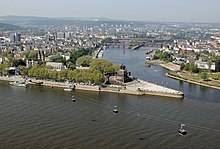Rhineland
|
Read other articles:

Сельское поселение России (МО 2-го уровня)Новотитаровское сельское поселение Флаг[d] Герб 45°14′09″ с. ш. 38°58′16″ в. д.HGЯO Страна Россия Субъект РФ Краснодарский край Район Динской Включает 4 населённых пункта Адм. центр Новотитаровская Глава сельского посел…
周處除三害The Pig, The Snake and The Pigeon正式版海報基本资料导演黃精甫监制李烈黃江豐動作指導洪昰顥编剧黃精甫主演阮經天袁富華陳以文王淨李李仁謝瓊煖配乐盧律銘林孝親林思妤保卜摄影王金城剪辑黃精甫林雍益制片商一種態度電影股份有限公司片长134分鐘产地 臺灣语言國語粵語台語上映及发行上映日期 2023年10月6日 (2023-10-06)(台灣) 2023年11月2日 (2023-11-02)(香港、…

非常尊敬的讓·克雷蒂安Jean ChrétienPC OM CC KC 加拿大第20任總理任期1993年11月4日—2003年12月12日君主伊利沙伯二世总督Ray HnatyshynRoméo LeBlancAdrienne Clarkson副职Sheila Copps赫布·格雷John Manley前任金·坎貝爾继任保羅·馬田加拿大自由黨黨魁任期1990年6月23日—2003年11月14日前任約翰·特納继任保羅·馬田 高級政治職位 加拿大官方反對黨領袖任期1990年12月21日—1993年11月4日…

Хип-хоп Направление популярная музыка Истоки фанкдискоэлектронная музыкадабритм-энд-блюзреггидэнсхоллджаз[1]чтение нараспев[англ.]исполнение поэзииустная поэзияозначиваниедюжины[англ.]гриотыскэтразговорный блюз Время и место возникновения Начало 1970-х, Бронкс, Нь�…

Wilkes-Barrecity(EN) City of Wilkes-Barre Wilkes-Barre – Veduta LocalizzazioneStato Stati Uniti Stato federato Pennsylvania ConteaLuzerne TerritorioCoordinate41°14′40″N 75°52′41″W / 41.244444°N 75.878056°W41.244444; -75.878056 (Wilkes-Barre)Coordinate: 41°14′40″N 75°52′41″W / 41.244444°N 75.878056°W41.244444; -75.878056 (Wilkes-Barre) Altitudine160 m s.l.m. Superficie18,6 km² Acque interne0,9 km² (4,84%) Abitant…

此条目序言章节没有充分总结全文内容要点。 (2019年3月21日)请考虑扩充序言,清晰概述条目所有重點。请在条目的讨论页讨论此问题。 哈萨克斯坦總統哈薩克總統旗現任Қасым-Жомарт Кемелұлы Тоқаев卡瑟姆若马尔特·托卡耶夫自2019年3月20日在任任期7年首任努尔苏丹·纳扎尔巴耶夫设立1990年4月24日(哈薩克蘇維埃社會主義共和國總統) 哈萨克斯坦 哈萨克斯坦政府與�…

Sulaiman Ar-Rasuli BiografiKelahiran10 Desember 1871 Candung Kematian1r Agustus 1970 (98 tahun)Candung Anggota Konstituante Republik Indonesia 9 November 1956 – 20 Juli 1957 – Kuasini Sabil → Terpilih dalam: Pemilihan umum Konstituante Republik Indonesia 1955 Data pribadiKelompok etnikOrang Minangkabau Syekh Sulaiman ar-Rasuli yang juga dikenal sebagai Inyiak Canduang (10 Desember 1871 – 1 Agustus 1970) adalah seorang ulama Minangkabau yang mendirikan Persatua…

School in AustraliaRose Bay Secondary CollegeLocationDover Heights,Eastern Sydney, New South WalesAustraliaCoordinates33°52′42″S 151°16′38″E / 33.87833°S 151.27722°E / -33.87833; 151.27722InformationTypeGovernment-funded co-educational dual modality partially academically selective and comprehensive secondary day schoolMottoOpportunity Achievement CommunityEstablished2003; 21 years ago (2003)School districtBondi; Metropolitan SouthEducational…

American novelist Alix Kates ShulmanShulman at discussion at Elizabeth A. Sackler Center for Feminist Art in 2010BornAlix Kates (1932-08-17) August 17, 1932 (age 91)Cleveland, Ohio, U.S.OccupationWriterNationalityAmericanEducationCase Western Reserve University (BA)Columbia UniversityNew York University (MA)SignatureWebsitewww.alixkshulman.com Alix Kates Shulman (born August 17, 1932) is an American writer of fiction, memoirs, and essays, and a prominent early radical activist of second-wav…

American photographer, theoretician, critic, and educator. Minor WhiteBorn(1908-07-09)July 9, 1908Minneapolis, MinnesotaDiedJune 24, 1976(1976-06-24) (aged 67)Boston, MassachusettsNationalityAmericanEducationUniversity of MinnesotaKnown forPhotography Minor Martin White (July 9, 1908 – June 24, 1976) was an American photographer, theoretician, critic, and educator. He had an intense interest in how people viewed and thought about photographs and a personal vision guided by several sp…

Fictional character in Assassin's Creed franchise Fictional character Haytham E. KenwayAssassin's Creed characterFirst gameAssassin's Creed III (2012)Created byUbisoft MontrealPortrayed byAdrian HoughIn-universe informationOriginLondon, England, Kingdom of Great BritainNationalityBritish Haytham E. Kenway is a character in Ubisoft's Assassin's Creed video game franchise. He is introduced as the false protagonist of Assassin's Creed III (2012), in which players control him for the game's initial …

This article is part of a series onConservatism in Denmark Principles Agrarianism Danish culture Canon Lutheranism Monarchism National romanticism Nationalism Nativism Patriotism Populism Property rights Rule of law State church Tradition Intellectuals Bjørnvig Kierkegaard Krarup Langballe Løgstrup Møller Oehlenschläger Politicians Kjærsgaard Krarup Langballe Mikkelsen Møller (Aksel) Møller (John) Møller (Per) Reedtz-Thott Schlüter Støjberg Vermund Ørsted Parties Conservative People's…

2002 single by Pink Just Like a PillSingle by Pinkfrom the album Missundaztood B-sideM!ssundaztoodReleasedJune 10, 2002 (2002-06-10)StudioPinetree (Miami Beach, Florida)GenrePop rock[1][2]Length3:57LabelAristaSongwriter(s) Pink Dallas Austin Producer(s)Dallas AustinPink singles chronology Don't Let Me Get Me (2002) Just Like a Pill (2002) Family Portrait (2002) Music videoJust like a Pill on YouTube Just Like a Pill is a song by American singer Pink. It was written…

Economic cost is the combination of losses of any goods that have a value attached to them by any one individual.[1][2] Economic cost is used mainly by economists as means to compare the prudence of one course of action with that of another. The comparison includes the gains and losses precluded by taking a course of action as well as those of the course taken itself. Economic cost differs from accounting cost because it includes opportunity cost.[3][2][4]…

1799 Battle during the War of the Second Coalition For Hannibal's battle of the Trebbia, see Battle of the Trebia. Battle of the TrebbiaPart of the Italian campaigns in the War of the Second CoalitionSuvorov's battle at Trebbia by Alexander Y. KotzebueDate17–20 June 1799[1][a]LocationTrebbia River in Po Valley, Duchy of Parma, Northern Italy; present-day Italian Republic45°3′0″N 9°36′0″E / 45.05000°N 9.60000°E / 45.05000; 9.60000Result Russo-…

Daging gajah yang disita oleh U.S. Customs and Border Protection Daging gajah adalah daging dan bagian pangan lain dari gajah. Sejarah Daging gajah tampaknya telah menjadi sumber pangan bagi manusia pada masa kemunculan spesies tersebut. Pada masa permulaan Palaeolitikum Pertengahan, sekitar 120.000 SM, masyarakat Afrika merupakan pemburu-peramu yang bergantung pada perburuan gajah untuk diambil dagingnya. Sebuah spesimen dari Palaeoloxodon antiquus yang sekarang telah punah ditemukan di Lembah …

British courtier and politician The Right HonourableThe Earl of Mount EdgcumbeGCVO PC DLLord Chamberlain of the HouseholdIn office7 May 1879 – 21 April 1880MonarchVictoriaPrime MinisterThe Earl of BeaconsfieldPreceded byThe Marquess of HertfordSucceeded byThe Earl of KenmareLord Steward of the HouseholdIn office27 June 1885 – 28 January 1886MonarchVictoriaPrime MinisterThe Marquess of SalisburyPreceded byThe Earl SydneySucceeded byThe Earl SydneyIn office16 August 1886 …

Road in Cardiff, Wales A4232Route informationMaintained by South Wales Trunk Road Agent (Capel Llanilltern – Culverhouse Cross Link Road) and Cardiff Council (all other Link Roads)Length17.4 mi (28.0 km)Existed1978[1]–presentHistoryConstructed 1978–2017Major junctionsWest end M4 (J33)Major intersectionsA48 A4050 A4055 A4234 A4161 A48East end M4 (J30) LocationCountryUnited KingdomPrimarydestinationsCardiff Road network Roads in the United Kingdom Motorwa…

Exciting or unusual experience Adventurer and Adventures redirect here. For other uses, see Adventure (disambiguation) and Adventurer (disambiguation). People on a coracle An adventure is an exciting experience or undertaking that is typically bold, sometimes risky.[1] Adventures may be activities with danger such as traveling, exploring, skydiving, mountain climbing, scuba diving, river rafting, or other extreme sports. Adventures are often undertaken to create psychological arousal or …

Lihat pula: Itzik Cohen (disambiguasi) Yitzhak CohenLahir2 Desember 1951 (umur 72)Tempat lahirAshkelon, IsraelKnesset14, 15, 16, 17, 18, 19, 20, 21, 22Faksi yang diwakili di Knesset1996–2018ShasJabatan menteri1999–2000Menteri Layanan Keagamaan2006–2008Menteri tanpa Portofolio2008–2009Menteri Layanan Keagamaan2015–Wakil Menteri Keuangan Rabbi Yitzhak Cohen (Ibrani: יִצְחָק כַּהְן, lahir 2 Oktober 1951) adalah seorang politikus Israel yang menjabat sebagai anggota Kness…






